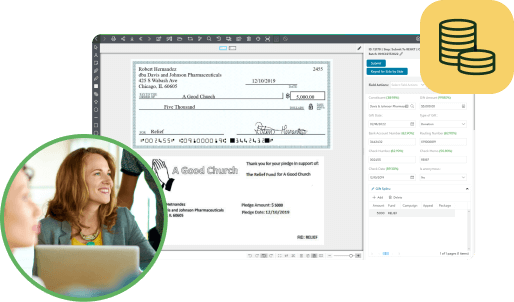Nonprofits work hard to raise money to support their missions and your organization is no different. You put together strategies, invest in fundraising software, and develop relationships that all lead to more funding for your mission.
However, even after all of this work, maintaining financial health may still seem like a losing battle. Between donor attrition, economic inflation, and other financial challenges, it can be difficult to raise enough money to keep up with your ever-growing needs. That’s why, in addition to your strong fundraising strategies, your nonprofit may decide to look for alternative ways to raise and maintain funding.
One such strategy is to invest your nonprofit’s money. Specifically, investing your reserve funds can help you earn more on your existing funds. To avoid buying, selling, and trading haphazardly, you’ll need to understand your goals and evaluate your investing options. In this article, we’ll discuss common investment questions, including:
- Why should nonprofits invest?
- Where can nonprofits invest their funds?
- How do nonprofits open an investment account?
- What should nonprofits invest in?
With a strong foundation and a detailed investment plan, your nonprofit will be set up to make your money work for you. Let’s get started.
Why should nonprofits invest?
Nonprofits often operate on a shoestring budget for extended periods of time to achieve their goals while working to build up a reserve fund. However, if you leave that money sitting in a money market, CD, or savings account, it’s likely losing value given the current inflation rates.
The idea of your hard-earned money losing value is enough to convince many organizations that it’s time to invest. But if you’re not convinced yet, Infinite Giving’s nonprofit investment guide provides these other reasons for investing your funds:
- Building assets. Over time, you can use your investment account to build assets for your nonprofit, helping you bolster your fundraising efforts and gain more capital for future growth.
- Long-term savings. On average, investment accounts tend to outperform savings accounts. This means that, especially given the high inflation rates of recent years, your organization can better keep up with (or even beat!) widespread economic inflation. In this case, investing will help you maintain financial stability over time.
- Courting large gifts. Major and mid-size donors may look at your organization’s financial information to confirm that you’ll use their funds responsibly if they choose to give. You can use your investment account to show donors that you’ll use their gifts wisely, growing them for years to come.
According to research from the MIT Sloan School of Management, only 11.2% of nonprofits hold investment accounts. This means that the majority of organizations are missing out on an opportunity to enhance their financial management plans with reserve funds.
Where can nonprofits invest their funds?
Before you start investing, you’ll need to develop a nonprofit investment policy statement that outlines your objectives, reporting standards, and other policies for your nonprofit. As you write this statement, you’ll also want to start thinking about your goals for your investment, which can help you during the process of determining where you’ll invest your funds.
Traditionally, there are five places where your nonprofit can invest its money:
- Big banks. Banks tend to have the greatest name recognition for investment opportunities. However, these accounts are often associated with fees, extensive paperwork, and a long timeline to get up and running.
- Wealth advisors. Almost 80% of active mutual fund advisors are falling behind the S&P 500 and Dow. While there is a slight possibility to beat the market, wealth advisors also often charge a high fee of 1% or more to manage your money.
- DIY. Through accounts like Fidelity and Schwab, your nonprofit can take a DIY approach and manage your own investment portfolio. While this may be a great way to decrease fees associated with your investment, it’s not recommended as a best practice. Not only could there be potential conflicts of interest with board members, but this approach also requires active and consistent oversight. This is often very difficult to accomplish with volunteer board members and rotating board terms. Plus, the DIY approach requires more time and energy, has limited accountability, and is often not the best use of your board’s time and skills.
- Automated investment accounts. From Treasury Bills to equities and bonds, these investment opportunities allow you to build wealth gradually, mirroring the market, while remaining low-cost and transparent. With a blend of passive investment and active oversight, automated investment accounts can help you preserve capital and raise more funds over time.
Explore each investment opportunity carefully, then consider the benefits and drawbacks of each one in relation to your nonprofit’s specific investment goals. For example, if you’re trying to maintain liquidity in your reserve funds and reduce your risk, you might choose to invest in Treasury Bills, Bonds, or money markets. However, if you’re trying to grow them ver time, you may consider securities and a more growth-oriented endowment strategy.
How do nonprofits open an investment account?
After you’ve considered your nonprofit’s investment options, reach out to a Nonprofit Investment Advisor to seek guidance and advice. Recommendations can be made based on your time horizons, risk tolerance, and financial goals. Investment is a part of nonprofit stewardship and should be done with care and consideration.
One such question to ask is if that advisor or manager has experience working with nonprofit organizations. Given the nature of restricted funds, fund accounting practices, and other unique financial situations nonprofits encounter, ensuring your investment advisor understands nonprofit needs is essential.
Then, you can start collecting the documentation you’ll need to start an investment account on behalf of your nonprofit. This documentation includes:
- An account application
- Your articles of incorporation
- A copy of your 501(C)(3) determination letter
After you’ve opened your account, you should start to think about how you’ll communicate with your supporters about your investments. Of course, they don’t need to know all of the ins and outs of your investment portfolio. But, you still should be transparent about your investments, dividends, and overarching financial information when you send out your annual report. Be sure you can pull reports from your investment account to help you develop this transparency.
What should nonprofits invest in?
Your investment portfolio is more than just an array of the most lucrative investments for your nonprofit. It’s also a reflection of your organization’s values and purpose. For example, it would seem hypocritical for a nonprofit focused on environmentalism to invest in an oil fracking company.
Nonprofits can invest in numerous different ways. Securities such as bonds, Treasury Bills, and mutual funds are often used as less risky investment types. You might also consider investing in crypto as another form of investment, especially if your donors want to donate in this form of currency. However, if you do decide to build a portfolio of different stocks, it’s important to choose options that best reflect your organization’s mission and values. For example, here are a couple of investment strategy types you might consider:
- Environmental, Social, and Governance (ESG) Investing – This type of investing focuses on ensuring the companies you invest in are responsible in the areas of environmental, social, and governance criteria. For the environmental criteria, review a company’s conservation process, carbon footprint, etc. For the social criteria, consider how companies treat their employees and customers, their diversity values, and community engagement. For governance criteria, look over how the company is run, its financial transparency, its political influence, and more.
- Thematic Investing – Thematic investing allows your organization to invest based on a specific industry or theme. For example, a church may choose to invest in only religiously-affiliated companies.
- Impact Investing – Impact investing describes the investment process of focusing on positive social or environmental impact. Even if your organization isn’t directly affiliated with an environmental cause, impact investing with a focus on environmentally friendly organizations can show your support for this value.
In addition to considering your own investment portfolio, think about the other ways you can leverage investments. For example, you may ask major donors to contribute toward your nonprofit’s endowment. These funds allow your organization to hold the principal amount contributed to the fund and invest it to grow. Then, a set amount of money (usually from the funds earned on your principal investment) is withdrawn on a set basis to cover specific expenses.
For example, a major donor for a university might contribute money for an endowment that supports a specific scholarship. Then, when that investment earns dividends or interest, that earned money can be given out as a scholarship.
NPOInfo’s wealth screening guide explains that many organizations looking for major donations will examine certain data points from their supporters, including their stock holdings. If you find that a supporter already owns a lot in stock, they may also be willing to donate that stock to your organization. These stocks can then be rebalanced as a part of your endowment or your general investment portfolio.
Investing is a smart move for any nonprofit trying to beat inflation and for those that want more out of their reserves. Consider your own investment goals and how you can use this process alongside effective fundraising to earn more for your mission.
Is your organization getting the most out of its main investment, its ERP or CRM? PairSoft’s natively integrated fundraising solutions have helped leading non-profits strengthen their financial workflows to boost the overall finance behind them. Get a demo today.






